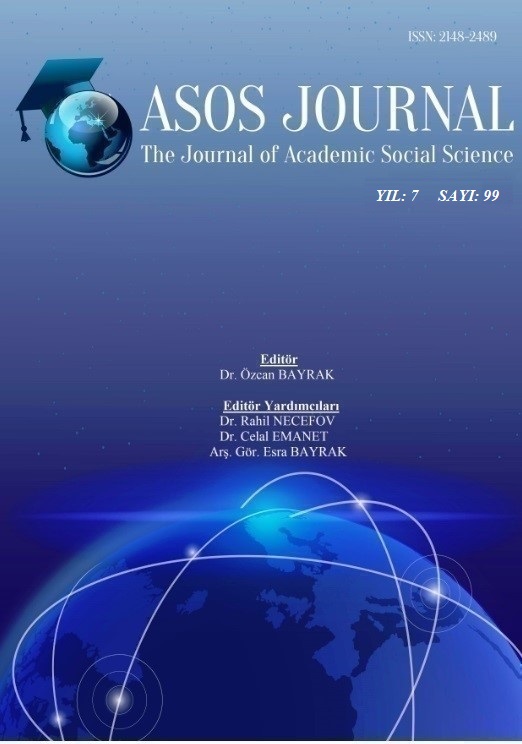Author :
Abstract
Geleneksel mutfak kültürü, bir bölgede coğrafi koşullar, bitki örtüsü, tarımı yapılan veya doğal olarak yetişen sebze, meyve ve yabani otlar ile o bölgedeki hayvancılığın ve bölge halkının kültürüyle bir araya getirilerek oluşturulan, bölgede gelenek haline gelmiş yiyecek kültürüdür. Geleneksel mutfak kültürünün sonraki nesillere aktarılması önemlidir. Mutfak kültürünü oluşturan unsurların kayıt altına alınıp literatüre sokulmaması bunların zamanla yok olmasına sebebiyet verecektir. Ağuz, Doğu Karadeniz mutfak kültüründe de bulunan geleneksel yiyeceklerinden bir tanesidir. Araştırmanın amacı, Trabzon’un Arsin ilçesinde yapılan ağuzun yapım aşamaları ve tüketim şeklinin derlenerek kayıt altına alınması ve gelecek kuşaklara aktarılmasıdır. Arsin’de yaşayan, kaynak kişi olma özelliklerine sahip ev kadınlarıyla nitel araştırma yönteminin kullanıldığı bu çalışmada veriler mülakat yolu ile elde edilmiştir. Hayvanın doğum yaptıktan sonraki ilk birkaç günlük sütünden yavruya yetecek kadar ayrılır ve kalanı bir kaba dökülür, ateşte ısıtılır. Süt kalıp gibi sertleşir, üzerine toz şeker veya pekmez dökülerek yenilir. Bu çalışmayla unutulmaya yüz tutmuş bir besin olan ağuzun kayıt altına alınması, tanıtılması mutfak kültürü açısından da önemlidir.
Keywords
Abstract
Traditional cuisine culture is a food culture that has become a tradition in the region by combining a culture of the people of the region with the geographical conditions, vegetation, cultivated or naturally grown vegetables, fruits and weeds with the animal husbandry. It is important to transfer traditional cuisine culture to the next generations. Failure to record and introduce the elements of the culinary culture into the literature will cause them to disappear over time. Ağuz, It is one of the traditional foods of the Eastern Black Sea cuisine. The aim of the research is to compile and record the stages of production and consumption of Ağuz made in Arsin district of Trabzon and transfer them to future generations. The qualitative research method was used in this study with the housewives living in Arsin who had the characteristics of being a source person and the data were obtained by interview. The milk obtained from the animal in the first few days should be kept and the amount required for the offspring should be set aside. the rest is poured into a container and heated over fire. The milk hardens like a mold and is eaten by pouring powdered sugar or molasses on it. It is also important for the culinary culture to record and introduce the apple which is a forgotten food with this study.
Keywords
- Akın, Galip, (2010), Geleneksel Mutfak Kültürü ve Yemeklerinin Ortaya Çıkışı ve Özellikleri, II.Uluslararası Doğu Anadolu Bölgesi Geleneksel Mutfak Kültürü ve Van Yemekleri Sempozyumu, 24-26 Kasım 2010, s. 324-329, Van, Türkiye.
- Akyürek, Suat, Zeybek, Halil-İbrahim, (2018), Gümüşhane İlinin Gastronomi Turizmi Açısın- dan Değerlendirilmesi, Social Sciences Studies Journal, 4(15): 869-882.
- Arıhan, Seda. (2012) Antik Çağda Beslenme, Beslenme Antropolojisi-I, Hatipoğlu Yayınları: 160, Beslenme ve Diyetetik Dizisi: 03, s. 45-78, Ankara.
- Baysal, Ayşe, (2002), Beslenme Kültürümüz, Kültür Bakanlığı Yayınları, Yayınlar Dairesi Başkanlığı, Ankara.
- Björk, P., Kauppinen-Räisänen, H. (2016). “Local Food: A Source for Destination Attraction”. International Journal of Contemporary Hospitality Management, 28(1), 177-194.
- Çokişler, Nazım, Türker, Ali, (2015). “Mutfak Kültürünün Turizm Ürünü Olarak Kullanım Et- kinliğininİncelenmesi: Ayder Turizm Merkezi Örneği”, Gümüşhane Üniversitesi Sosyal Bilimler Elektronik Dergisi, 6 (14), 122-136.
- Girgin, Göksel-Kemal (2018), Yerel Gıdaların Tüketilmesine Yönelik Turist Motivasyonlarının Ölçülmesi:Antalya’da Bir Uygulama, Atatürk Üniversitesi Sosyal Bilimler Enstitüsü Dergisi Nisan 2018 22(Özel Sayı): 793-810.
- Kabasakal, Adem, (2008), Süt Üreticilerinin Uygulamadaki Tutumları ve Verime Olan Etkisi, Balıkesir Üniversitesi, Fen Bilimleri Enstitüsü, Balıkesir.
- Kalafat, Yaşar, (2007), Balkanlar’dan Uluğ Türkistan’a Türk Halk İnançları II, Berikan Yayın- ları, Ankara
- Metin, Mustafa, (1998), Sütün Bileşimi ve İşlenmesi, Süt Teknolojisi, Ege Üniversitesi Basıme- vi, İzmir.
- Özkaya, F. Durlu, Gün, İlhan, (2007), “Anadolu’da peynir kültürü”, Uluslararası Asya ve Kuzey Afrika Çalışmaları Kongresi, 10-15 Eylül 2007, Ankara, Türkiye.
- Paksoy, Nilgün, (2017), Akçakale ve Halfeti İlçelerinde Yetiştirilen İvesi Koyunlarda Süt De- mir Düzeylerinin Değerlendirilmesi, MAE Veteriner Fakültesi Dergisi, 2 (1): 17-23.
- Şen, Mehmet-Akif, (2018), Sanayi Kenti Gebze’den Geleneksel Bir Lezzet “Ekşi Mayalı Ek- mek”,Akademik Sosyal Araştırmalar Dergisi, 6(82), 338-351.
- Yerli, Yusuf, Şen, Ali, Özbay, Merve, (2018), Dolaz Peyniri Üzerine Nitel Bir Araştırma: Yal- vaç Örneği, Güncel Turizm Araştırmaları Dergisi, 2(Ek.1), 630-636.





